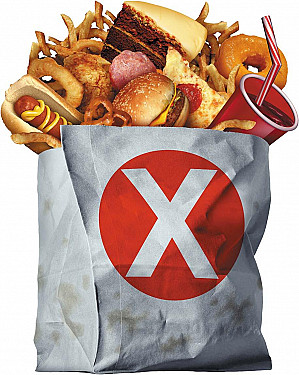Cut calories or carbohydrates for better heart health?
Depending on your weight and other heart-related risks, eating far fewer carbs may be a smart strategy, according to a new model of the underlying cause of obesity.
- Reviewed by Christopher P. Cannon, MD, Editor in Chief, Harvard Heart Letter; Editorial Advisory Board Member, Harvard Health Publishing

Anyone who's tried to lose weight by cutting calories knows that this approach can work, but it's very hard to sustain and then maintain any weight loss. Why? Your body fights against your best efforts with a primal, biologically driven one-two punch. First, you feel hungry — your body's way of telling you to replenish those missing calories. Even if you resist those hunger pangs for a few days, you're hit with the second blow: a slower metabolism, spurred by your body's response to conserve energy. To keep losing weight, you have to keep eating less and less, even as your hunger increases.
"It's a battle between mind and metabolism that few people win," says Dr. David Ludwig, professor of pediatrics at Harvard-affiliated Boston Children's Hospital. That's why he endorses a different way of thinking about (and addressing) excess weight and its related risks. Known as the carbohydrate-insulin model of obesity, it considers the biological mechanisms that promote weight gain — specifically, how our bodies respond to processed carbohydrates.
These foods (made mainly from refined starchy foods and sugar) flooded the American diet during the low-fat craze that began in the 1990s. Eating these fast-digesting carbs causes your body to release large amounts of insulin, the hormone that enables cells to absorb glucose (sugar) for energy. But as insulin levels rise, excess calories are stored as fat. And when your fat cells suck up too many of the calories you consume, there are too few calories for the rest of the body, making you hungrier and therefore more likely to overeat.
What drives overeating?
The new scientific model, described in the December 2021 issue of The American Journal of Clinical Nutrition, may sound counterintuitive. But it's analogous to two other states of growth: puberty and pregnancy. During a growth spurt, a teen may consume as many as 1,000 extra calories a day than earlier in childhood. But overeating isn't what makes teenagers grow taller and bigger. Rather, it's the use of extra calories to create new body tissues that makes teens hungry, so they eat more. And in a pregnant woman, it's the fetus absorbing calories from her blood that prompts her food cravings and hunger — not the other way around, Dr. Ludwig explains. Likewise, the body's process of storing too much fat triggers overeating.
"Obesity is caused by many factors, and diet isn't the whole explanation," Dr. Ludwig says. But by cutting back on carbs, you can shift your metabolism in ways that help promote weight loss without triggering excessive hunger — and, at the same time, improve common risk factors for heart disease. Just how much you might consider reducing your carb intake varies depending on your health parameters, which Dr. Ludwig divides into three categories, described below.
Stage 1
For many people, the problem is avoiding that annual pound or two of weight gain that often happens as we age, says Dr. Ludwig. It's common for relatively lean young adults to slowly become overweight by middle age. "For these people, simply reducing processed carbohydrates, such as sugary drinks and desserts, white bread, potatoes, and white rice, might be enough to shift their trajectory and maintain a healthy weight," he says.
The flexible diet for these people can look a lot like the traditional Mediterranean diet, with about 40% of the calories from fat and 40% from carbs. (The average American diet today includes about 50% of calories from carbs, most of them highly processed.) There's still plenty of room to enjoy minimally processed whole grains (such as traditional whole-kernel or stone-ground whole-grain breads), whole fruits, legumes, and the occasional sweet treat, Dr. Ludwig says.
Stage 2
But what about people struggling with significant excess weight or obesity, along with related health complications like high blood pressure and cholesterol levels, or a condition exacerbated by weight, such as non-alcoholic fatty liver disease or sleep apnea? For these people, a diet much lower in carbohydrates — around 25% of calories — can be a more effective way to lose weight and improve the associated risks, according to Dr. Ludwig. With this diet, people can eat plenty of vegetables (with the exception of starchy vegetables such as potatoes, sweet potatoes, corn, and peas) and one or two servings of fruit per day, as well as one serving of beans or legumes and one serving of whole grains (see "A sample daily menu for a 25% carbohydrate diet"). About half of the calories in the diet are from fat, which helps people feel full and not deprived. Tasty and healthy sources of fat include nuts, avocados, olive oil, and fermented full-fat dairy products like Greek yogurt and kefir.
|
A sample daily menu for a 25% carbohydrate diet |
|||
|
Breakfast |
Lunch |
Dinner |
Snack |
|
Crustless Quiche mini-muffins Bacon, turkey bacon, or vegetarian sausage* 100% whole-grain sourdough bread |
Salmon Salad in a lettuce wrap** Apple |
Moroccan Chicken Stew with Apricots** Cauliflower "rice" Mixed salad with mustard vinaigrette Berries and dark chocolate (minimum 70% cocoa) |
Roasted nuts (almonds, pecans, walnuts) |
|
*Most cardiologists suggest limiting processed red meat like bacon to no more than a few servings a month. |
|||
Stage 3
This very-low-carb diet, which includes at most 10% of calories from carbs, can benefit people with type 2 diabetes, who are effectively "carbohydrate intolerant," says Dr. Ludwig. Studies show that this eating pattern can lead to impressively stable blood sugar values. But it's quite restrictive and should be done only under the guidance of a doctor and dietitian. Although a very-low-carb diet is challenging to follow initially, people often find it easier to lose weight with this approach compared with other diets. Because they feel better physically, they're often motivated to stick with the diet.
Image: © PaoloBis/Getty Images
About the Author

Julie Corliss, Executive Editor, Harvard Heart Letter
About the Reviewer

Christopher P. Cannon, MD, Editor in Chief, Harvard Heart Letter; Editorial Advisory Board Member, Harvard Health Publishing
Disclaimer:
As a service to our readers, Harvard Health Publishing provides access to our library of archived content. Please note the date of last review or update on all articles.
No content on this site, regardless of date, should ever be used as a substitute for direct medical advice from your doctor or other qualified clinician.
















